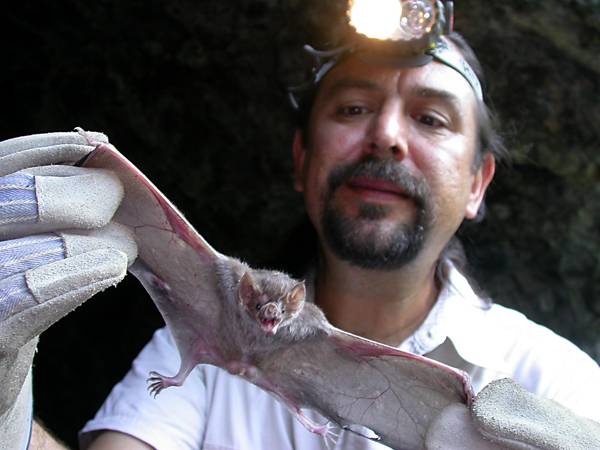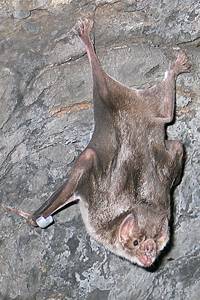Warmer winters could prove inviting for invasive vampire bats
Posted by Jayme Blaschke
University News Service
February 13, 2012
|
Vampire bat |
Texans are used to putting up with the consequences of notoriously hot summers, but if researchers’ predictions are correct, then record drought and wildfires won’t be the only hazards residents of the Lone Star State will have to contend with in the future.
Vampire bats may be on the way.
Once only seen in the U.S. in horror films, vampire bats are expanding their range in Mexico as a result of climate change, and computer models indicate they could become year-round Texas residents within 50 years. For Ivan Castro-Arellano, a biologist and wildlife disease expert in the Department of Biology at Texas State University-San Marcos, the concern is that Texas’ increasingly warmer winters might allow the damaging pest to expand into the state well ahead of schedule. Castro-Arellano is one of more than 40 scientists throughout the Texas State University System working through the Institute for the Study of Invasive Species in Huntsville to study and develop strategies to deal with invasive species across the state.
“They will not survive in places that go below 10 degrees Celsius (50° Fahrenheit) for a sustained period of time. Models predict those minimum temperatures are going to rise from where they are now. If that happens, obviously they are going to advance,” Castro-Arellano said. “However, there are many ways the animals may escape that restriction. The models are an oversimplification, because if the animals can find a place to roost during the day that keeps them warmer than that 50 degree limit, then they will be able to exploit new areas, especially in Texas.”
The warming trend in Texas is reflected in the recently-updated USDA plant hardiness zone map, which generally revised minimum winter temperatures upwards 5°F across the state. That climate shift pushes the Lone Star State one step closer to becoming suitable habitat for vampire bats.

Arnulfo Moreno-Valdez, director of the Natural Museum of Tamaulipas in Mexico, displays a vampire bat.
(Photo courtesy of Arnulfo Moreno-Valdez)
While native Texas bats are beneficial, eating tons of insects that would otherwise damage crops that make up a large part of the state’s agricultural industry, vampire bats could pose a big threat to livestock. The bats target cattle and other livestock, approaching the animal on the ground and licking it with anesthetic saliva that also prevents blood from clotting. Then it bites the victim with razor-sharp teeth and laps up the free-flowing blood. Since they feed on mammals, they can easily spread rabies and infect herds of domestic livestock. They also tend to target the same victim night after night, and repeated feedings can kill individual animals. Vampire bats cost ranchers in Mexico millions of dollars each year in losses.
“If the animals get here, for cattle ranchers that’s a real problem,” Castro-Arellano said. “As you can see, there are conservation implications and economic implications for these species that can come into Texas in the future.”
Because bats can easily fly hundreds of miles, an immediate concern for Castro-Arellano is that vanguard colonies of vampire bats may already be venturing into South Texas, only to flee south or die off during cold winter weather. Very mild winters, such as the state is experiencing this year, play into the idea such isolated colonies may find roosts that offer plenty of warmth and protection to become a year-round threat. The key, Castro-Arellano said, is to identify such potential roosts before any vampire bats arrive and effectively monitor them.
If funding can be found, Castro-Arellano plans to explore probable sites where vampire bats might roost and place remote thermometers in those locations to record temperatures throughout the winter. If local microclimates show stable temperatures suitable for vampire bats over a series of years, that data would serve as an early warning. Strategies for dealing with vampire bats have been developed in Mexico, but they’re most effective if they can be implemented before a colony becomes well-established. That means preparation is key.
“Before they arrive, let’s locate the places they might live, and let’s monitor the temperatures,” he said. “You can start seeing microclimates, and see that suitability for them in those microclimates--then we’ll start to worry about it.
“To make it perfectly clear, right now we’re not doing any of that. There is no funding,” Castro-Arellano said. “After that data is in, you can predict the places they are going to be, and you can monitor those places to see if they’re really there. But we have no way to collect that data now.”
Fortunately, Castro-Arellano is an adjunct researcher with the Natural Museum of Tamaulipas as well as a close collaborator with that institute’s director, Arnulfo Moreno-Valdez. Moreno-Valdez happens to be one of the top authorities on vampire bats. The two researchers have already discussed combining their efforts to tackle the problem posed by the spread of vampire bats from both sides of the border.
“This is a best-case scenario, because this guy is an expert on bats in eastern Mexico, and I can be on the other side,” Castro-Arellano said. “This is the kind of research you need both sides of the border to cooperate, otherwise it is not going to work. That’s what we’re here for, trying to do research and tackle these questions.
“I think the scenario is set. It’s obviously not going to happen next year, but if we don’t anticipate their arrival, by the time these animals are here we will be ill-prepared,” he said. “It’s mostly preparation, which I think will be a good strategy, because the investment is going to be little compared to the probable impact. That’s the cost/benefit ratio of doing things versus not doing anything. With vampire bats, it’s a no brainer.”
